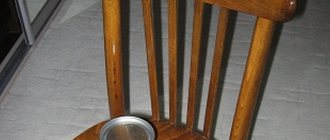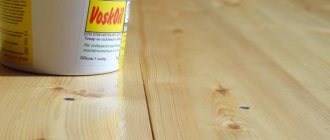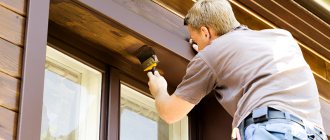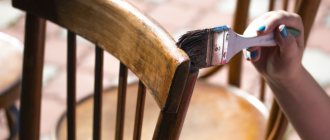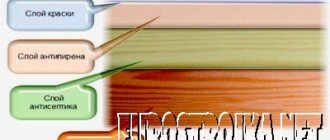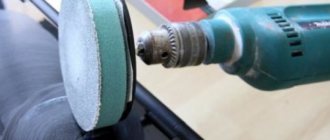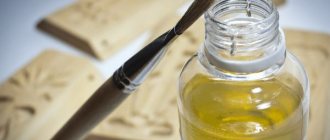In order for a wood product to last longer and not deteriorate too quickly under the harmful influence of natural factors, you need to do a special surface treatment. Impregnation for wood is one of these means of protection, characterized by a number of positive properties. More details about the characteristics and types of impregnations, of which you can find a large number on the market, will be discussed below. After all, the correct choice of product is the main guarantee of obtaining reliable coverage.
Why do you need to impregnate wood?
Wood is invariably popular in various fields, this is due to its environmental friendliness, strength, hygroscopicity, sound-proofing and heat-insulating properties. It should also be noted its beautiful external qualities and ease of working with the material. However, in order for a wooden product to last for a long time, it is impossible to do without providing a protective coating.
Without a layer of protective material, the tree is subject to rot and destruction due to various factors that affect the structure of the wood. Therefore, a variety of antiseptics and materials have been created that are used to impregnate the surface of products. Their goal is to protect the material from:
- Fungal formations;
- Mold formation;
- The appearance of rot;
- Insect colonization;
- Exposure to ultraviolet rays;
- The influence of temperature changes;
- Impact of various types of natural precipitation;
- Mechanical impact;
- Pollution.
In order for a wooden product to last for a long time, it is impossible to do without providing a protective coating.
Proper grinding
A step-by-step proven method on how to properly sand a pine board:
- to begin with, you can take coarse-grained discs for a grinder and, changing them in descending order, finish the procedure with disc No. 180;
- then, additionally sand it manually using a block with sandpaper No. 180. It is necessary to move along the fibers: this will remove marks from the sander;
- The final stage is sanding the ends with sandpaper with grit No. 220. This will prevent them from excessively absorbing the stain.
Which is better: varnish or impregnation
Determining which product will be better than impregnation or varnish is based on the type of wooden object or structure, as well as the conditions of its use. The surfaces and products best suited for their treatment will be listed below:
- If you need to treat the surfaces of a bathhouse or sauna, where there are high levels of humidity and temperature, it is better to impregnate the wood with a water-based impregnation;
- Cover the surface of the dining table or kitchen countertop with an optimal impregnating agent based on wax or a mixture of natural oils. The price of such products is high, but they create a reliable layer that does not harm human health;
- Wood floors at home can be painted using a variety of paints. To preserve the natural wood pattern, warmth and texture of the material, oil impregnations are used;
- To ensure that parquet boards last longer and the coating does not wear out, they are coated with polyurethane varnish. He does a great job of this;
- Furniture is usually produced varnished.
Wood floors at home can be painted using a variety of paints.
Pine primer
Experience in processing pine wood shows that applying stain to its clean surface leads to uneven tone and staining.
The carpenters conducted an experiment with test samples to determine which primer composition would provide better color uniformity. The surface was treated with shellac for furniture, a factory primer-conditioner for wood with uneven absorption and a polyurethane composition. The latter showed the best result.
After applying and drying the composition, the surface is lightly sanded in the direction of the fibers with a sponge with abrasive No. 320 and a liquid stain is applied.
Functions of wood impregnations
Impregnation of wood is necessary to fill all the pores, because it has a liquid consistency, often it is as liquid as water, sometimes gel-like. This quality allows it to completely saturate the wood, leaving no opportunity for moisture to penetrate inside. This tool also performs the following functions:
- Serves as an obstacle to the colonization of the tree trunk by insects, which use it as a place of protection from birds and other enemies;
- Barrier to the appearance of fungi and mold. The white house fungus most often affects wood; the walls of houses are usually affected by pink growths of fungi with a yellowish tint. When too much surface area is covered with fungus, the house is filled with a sour smell, and the destruction of the wooden structure occurs very quickly;
- Gives resistance to fire, which will make living safer;
- Creates a dirt-repellent layer. When a wooden surface is not treated with anything, dirt penetrates deep inside and it is very difficult to clean it; the use of impregnation makes it easy to wash out dirt;
- Improving decorative properties. Sometimes when choosing a product, they are guided by the color of the product; by treating the wood with the appropriate color, you can create the effect of an expensive material; pine can be coated, imitating a more expensive species.
Wood impregnation is necessary to fill all pores.
How to apply with a brush
It is advisable to use flat brushes: the wider the working part, the better - this will reduce the risk of layers of impregnation overlapping each other, which leads to uneven shade. Apply first along the length, then along the width, and then again along the length. That is, with cross-shaped movements. After 1 – 2 min. the remains are leveled with the same brush, but clean and dry - this additionally levels out the difference caused by the uneven absorption properties of the wood. A rich, even layer of impregnation left on the surface will provide a spectacular appearance to the treated surface.
Which wood impregnation is better: main types by composition
Various components are used to produce impregnations; they affect the resulting effect. Therefore, you should understand the different types, then choosing the appropriate option will be easier.
Various components are used to produce impregnations; they affect the resulting effect.
Water-soluble and oil-based
Water-based solutions are safe for humans, without a strong odor, dry quickly, and can be applied to a damp surface. Disadvantages: penetration depth is low, cannot be used on objects that have constant contact with water, they protect only superficially.
Oil paints are characterized by a high penetration depth, create a reliable layer against moisture, are commonly used for painting objects located outside, and create a shiny coating. They do not have fire protection properties and are short-lived.
Oil-based products have a high penetration depth and create a reliable layer against moisture.
Solvent based
Designed for covering facades, they are distinguished by elasticity and moisture-repellent properties. Good adhesion to the surface, therefore it is used before using paints.
Designed for covering facades, they are distinguished by elasticity and moisture-repellent properties.
Alkyd and acrylic
Alkyd solutions contain the same resins, wax, and oil. Protects against natural precipitation and impacts, preserving the natural grain of the wood. The downside is the difficulty of application; you need to work with a roller or brush, which delays the process.
Acrylic products are suitable for interior and exterior decoration. They are environmentally friendly, moisture-proof, strengthen the wood base, prevent rotting, and serve as protection against biological influences. They do not tolerate low temperatures well.
Acrylic products are suitable for interior and exterior decoration.
Salt and bitumen based
The salt form is sold ready-made or as a powder that needs to be diluted. Protects against biological influences and pests, creates a fire-resistant coating. Their use with a brush reduces the resulting properties. It is better to soak objects in them or use them in a vacuum chamber. For this reason, they are rarely used in everyday life, more often for industrial purposes.
Bitumen impregnation is thick and black in color. Usually it is prepared independently and is used to cover objects located outside the building. The layer turns out dense.
Bitumen impregnation is thick and black in color.
Choosing the “right” boards
Pine has significant knotiness, but in our case this is part of its attractiveness and uniqueness. Regular, non-rotten, hard knots, which are an integral part of the structure of the board, are not a hindrance, but “dead” such elements of wood should be avoided. That is, the rotten ones, those that stagger, fall out. Also, boards with accumulations of these formations near the core or with knots around which the wood grain lines sharply change direction should be rejected.
But even boards with these disadvantages are quite suitable for use. The problem can be solved in a simple way: by securing the falling knots with epoxy glue. Do not be afraid that over time its adhesive properties will weaken and the board element will fly out or crumble. This glue is based on epoxy resin, which is extremely durable after drying.
How to choose the best wood impregnation: consider the purpose of the purchase
Impregnation should be selected based on the location of the item being processed. What is suitable for finishing work indoors will not be suitable for items used outdoors.
Impregnation should be selected based on the location of the item being processed.
For interior work
Working inside a building requires the environmental friendliness and safety of impregnated components. It is optimal to use water-based solutions. Suitable products: antiseptic, moisture-resistant, fire-resistant.
It is optimal to use water-based solutions.
For outdoor use
Wood impregnation for exterior work is used as a barrier against the harmful effects of the environment. The use of antiseptic substances is optimal.
Wood impregnation for exterior work is used as a barrier against the harmful effects of the environment.
Important Features and Tips
Coniferous wood tends to yellow over time, so you should choose light or gray stains. It is recommended to use only varnishes that are resistant to fading.
Experts recommend first testing the impregnation on a prototype and coating the surface with varnish. That is, process the sample completely to the end: this way the result of the combination of stain and the selected varnish will be visible, which will allow you to check whether the tone created as a result of the “collaboration” of these two substances is suitable for the master.
Wood, and especially its conifers, has a certain degree of unpredictability in the light of the work we describe. There is a possibility of tonal color changes occurring over time.
Containers used during operation must be as clean as possible and consist of identical material. If impregnations are mixed, then this must be done extremely carefully in the same container. If it consists of metal, then its impurities may slightly change the tone.
To create tones in the light or gray range, you should select wood that is as close to them in color as possible. In addition, the result largely depends on the structure of the tree. For example, it is influenced by the quality of the solid rings of this material.
Rules for treating wood with impregnation
To obtain the maximum effect from applying impregnation, the process must be carried out according to the following rules:
- Mixtures with low viscosity are applied with a spray gun, with high viscosity - with a roller or brush;
- Drying times vary; information can be found on the solution packaging;
- Toxic and pungent-smelling impregnations that have a negative effect on the human body must be used in special protective elements;
- When working, you need to make sure that there are no children or animals nearby;
- The packaging indicates the number of layers to be applied to obtain optimal protection; these numbers should be adhered to;
- Renew old impregnation according to the time limits recommended by the manufacturer.
Drying times vary; information can be found on the solution packaging.
What is the best way to carry out stain application work?
It is fashionable to apply stain to the surface using several tools:
- Spray gun. Used for applying nitro stains and alcohol stains. Since they dry quite quickly, stains may appear on the painted areas, and when using a spray gun, the material is distributed more evenly to the surface. Also, the use of this application method is justified when working with a large area of painted surfaces.
- Paint brushes. They are mainly used for applying oil and water based stains. Moreover, for the former, brushes with natural bristles are more suitable, and for the latter, brushes with synthetic bristles. When working with brushes, you need to make sure of their quality. During the process of applying the material, the brush should not “lose” its bristles. Otherwise, it can ruin all the work.
- Rags and foam swabs. Suitable for working with water and oil stains, if the surface area to be painted is not too large.
The best brands of wood impregnations according to their intended purpose
The best impregnation for wood against moisture and rot is determined by its purpose and area of application. The purpose of the product may vary, so different compositions are used. To choose the right brand, you need to understand which products are best suited for what.
To choose the right brand, you need to understand which products are best suited for what.
Antiseptic
Antiseptic agents produce a whitening effect and are usually used to cover surfaces that have lost their aesthetic appearance. In the ranking of such solutions, the leaders were: Prosept 50, Senezh Effo, Neomid 500, Fongifluid Alpa.
Antiseptic agents produce a whitening effect and are usually used to cover surfaces that have lost their aesthetic appearance.
Fire protection
These products are used for interior work. To get the desired result when purchasing, you need to ask the seller for a quality certificate.
For outdoor work, Senezh Ognebio or Ognebio Prof are popular; for indoor work, products called Pirilax and Neomid 450 are popular.
To get the desired result when purchasing, you need to ask the seller for a quality certificate.
Frost-resistant
Frost resistance of impregnations can reach a protection level of up to -40 degrees. The following types of brands are distinguished here:
- Alpa Polyfluid;
- Texturol Bioprotection;
- Alpa Elan Lasure;
- North Krasula.
Frost resistance of impregnations can reach a protection level of up to -40 degrees.
Water repellent
For those surfaces that are regularly exposed to moisture, the following impregnations are produced: Senezh Ultra, Valti Akvacolor, Neomid 430 Eco. All of them create a reliable layer against moisture absorption.
For those surfaces regularly exposed to moisture.
Decorative
Decorative ones are used as a finishing coating, inside and outside the building. They help to emphasize the wood pattern, the surface will not crack, and slow down aging. The following products stand out:
- LuxDecor;
- Saitex;
- Aquatex;
- Valtti Akvacolor.
They help to emphasize the wood pattern, the surface will not crack, and slow down aging.
Complex
There are complex options that combine a whole range of components that protect the surface of the wood from the influence of moisture, fungi and mold. Two products can be noted - Krasula and Prosept Sauna.
There are complex options that combine a whole range of components that protect the surface of the wood from the influence of moisture, fungi and mold.
Tex products: Biotex antiseptic
The products of the famous brand "Tex" are represented by a large assortment of paints and varnishes. Products from one of the leaders in the paint and varnish products market guarantee an optimal price/quality ratio. The packaging contains a description of technical characteristics and recommendations for use.
Every year, developers offer something new to replenish the range of 9 groups of paints and varnishes. It includes façade and interior varieties. Main list of TEX products:
- Primers;
- Antiseptics;
- Water-dispersed dyes;
- Varnishes on different bases;
- Alkyd enamels;
- Oil paints;
- Specialized enamels;
- Plasters and putties;
- Adhesive compositions.
All BIOTEKS products are classified as water-soluble compounds and organic-soluble mixtures. To increase the period of impeccable operation of wood, which has retained high decorative properties, universal (multicomponent) impregnations are used.
All BIOTEKS products are classified as water-soluble compounds and organic-soluble mixtures.
Color
When there is a desire to leave a natural pattern, a colorless impregnation is selected. To obtain an imitation of other expensive types of wood, color compositions of corresponding brown shades are used.
Coloring and impregnation should not be confused. Painting is the creation of an opaque layer, impregnation implies transparency and preservation of the structure.
When there is a desire to leave a natural pattern, a colorless impregnation is selected.
"Biotex Universal"
The antiseptic of the Biotex Classic series remains one of the most popular products for construction and household purposes. A universal remedy is available to everyone, regardless of financial level.
Effective protection - colorless primer "Biotex Classic Universal". Suitable for exterior work and finishing of ventilated premises - outbuildings, gazebos, garages, balconies.
For tinting the floors of a veranda or gallery, dark shades are suitable - cherry, teak, mahogany, rosewood. The effect is no worse than any matte Biotex paint.
The primer composition is adapted for coating with oil paints and enamels. Not suitable for frozen and contaminated wood.
For tinting the floors of a veranda or gallery, dark shades are suitable - cherry, teak, mahogany, rosewood.
Tinting of impregnations
Tinting will be very difficult, it is better not to waste time and effort on this. After all, getting the right shade on your own is almost impossible. There are many shades available on the market, from which you can easily choose the right one.
There are many shades available on the market, from which you can easily choose the right one.
Recommendations from experts
- When choosing an impregnation for wood, it is important to pay attention to several aspects, and first of all, the price of the material. The more any product costs, the more profitable it is to counterfeit it. In this regard, products produced by domestic manufacturers (Senezh and Neomid) seem safer. Their cost is low, which means that counterfeiting these products is not very profitable, although the quality of these products is practically not inferior to the best branded samples from Western manufacturers.
- Before deciding which impregnation is best for you, think about whether additional tinting of the surface is needed. After all, impregnations can be multifunctional, that is, they can perform several tasks at once - not only protect the wood from certain influences, but also give the coating a changed appearance. If you take this point into account, you can save a little.
- Next, you need to evaluate the amount of work and, in accordance with this, calculate the required amount of impregnating material.
- Before purchasing, check to see if there are any cloudiness or iridescent spots on the surface of the liquid. If there is, it means that the product contains diesel fuel. It is better to refrain from purchasing such products. Most likely, this is either a low-quality impregnation or an outright counterfeit.
- To apply impregnation to the surface more quickly and evenly, it is better to use a sprayer, although if this tool is not available, you can use a brush or roller.
- Be sure to wear a respirator! The guarantee of 100% health safety indicated on the product label is nothing more than an advertising gimmick by marketers. Any antiseptic impregnation contains volatile benzene fractions. Their vapors are harmful even in small concentrations.
Wood antiseptic is 4 times cheaper than in the store. Do-it-yourself according to GOST

